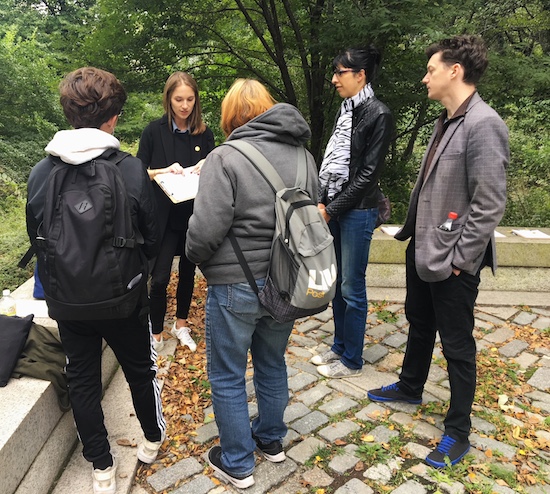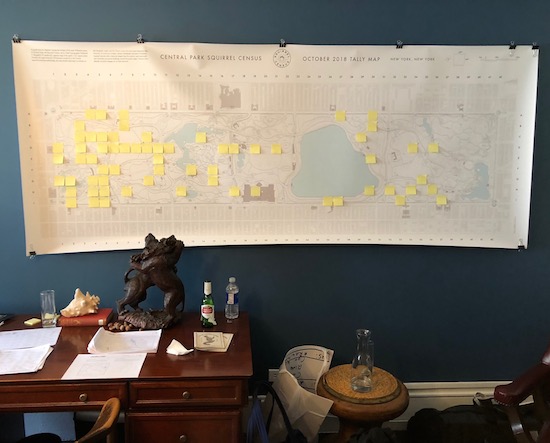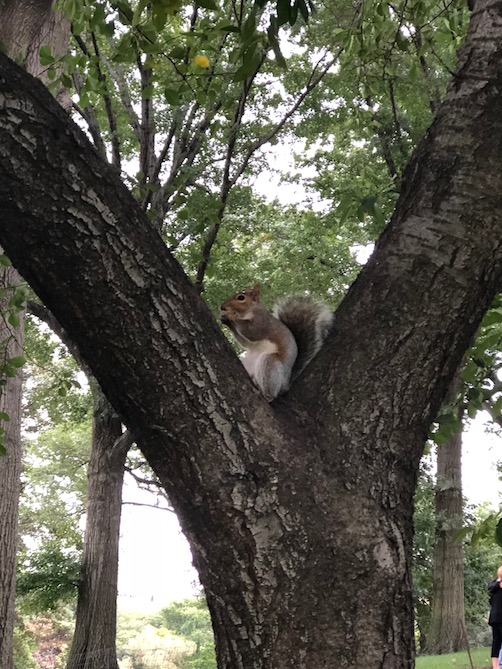
Squirrel Census cartographer Nat Slaughter shows squirrel sighter Gabriel Galperin the official census map.
By Kate Koza
The hunt for the great Sciurus carolinensis, otherwise known as the Eastern Gray squirrel, is in its final week in Central Park. The folks behind the Central Park Squirrel Census have, as of Wednesday, shepherded over 80 groups of volunteers into the wilds of our city’s behemoth 840-acre crown jewel of parks in pursuit of something so ubiquitous that most of us rarely notice them, let alone stop to observe their individualities and traits.

Official Squirrel Census sighter tally sheet.
Much has been written about the reasons for the census (the cultivation of scientific data that can indicate everything from behavioral patterns to the broader health of local habitats), its origins (a similar 2012 study of Atlanta’s Inman Park), its methodologies (including an algorithm known as Flyger’s formula that answers the question on everyone’s mind –– How does one avoid the disastrous statistical implications of counting the same squirrel twice?). Less has been said about the experience of participating in the census as a volunteer.

Training new squirrel sighters.
Two Sundays ago, I showed up at my designated volunteer meet-up spot, a triumphal statue of the Polish king Wladyslaw II Jagiello, created for the Polish pavilion in the 1939 New York’s world fair. Despite having lived less than a mile away for over six years, I had never been to this tucked-in spot in the park. I was delighted to find, upon my arrival, that the round pavilion in front of the statue is also home to an informal Sunday meet-up group of New Yorkers who have an affinity for Eastern European step dancing. As they linked hands and moved in time to music likely older than all of us, my little group of Squirrel Sighters (the official title of census volunteers) assembled around the king, ready to receive our marching orders.
Our group’s official Squirrel Scout –– that is, the person who would be training us in just how to properly count squirrels –– was Nat Slaughter, who also happens to be an official member of the census team and the project’s chief cartographer. Something that may not be so intuitive for casual consumers of Squirrel Census media coverage is that in order to undertake such a project, an incredibly detailed map of the park is required. A map so detailed, in fact, that it didn’t yet exist. Over the past year, Nat, a DC resident who works for a digital mapping company, has traveled to New York to roam the park on weekends and carefully denote its innumerable geographic and architectural features.

The census map on the wall of the Explorer’s Club, home base for the census team.
The section of the park that my volunteer group would divide and conquer, one of four, was carefully divided into hectares –– 100 x 100 square meter spaces, most of which could be identified on the map by natural or architectural landmarks that fell within their boundaries. We were each assigned two hectares in which we would spend 20 minutes looking for squirrels and documenting their characteristics and behaviors. Each squirrel we happened to sight would be subject to a thorough characterization: Adult or juvenile? Gray, black, cinnamon, or white? On the ground or in a tree? How high in that tree? Running, chasing, climbing, eating, foraging, or brushing its teeth? Displaying typical squirrel sounds or tail motions – Kuks? Quaas? Moans? (The dichotomy of these vocalizations is worth looking up on YouTube.) Tail flags? Tail twitches? Friendly? Indifferent? Requests directions? Follows you home?
After this first experience as a sighter, I was –– somewhat miraculously, given my level of experience –– promoted to Squirrel Scout and given a chance to lead a few groups of my own. In one, a father and daughter showed up from Georgia having driven up overnight to participate. A local reporter showed up and followed their expedition, and all parties were amiable when they ended up being the only group not to see a squirrel that morning (not sighting a squirrel, Nat pointed out, is just as important as sighting a profusion squirrels). Another favorite group included a mother and son team –– Nina and Gabriel. Gabriel embedded under a tree, and a squirrel on its lower truck seemed almost to be in silent conversation with him as he observed.
Like all of history’s great explorers, Ishmael to Shackleton, my sighters fanned out across our little corner of wilderness with nothing but a clipboard and a dream. In addition to squirrel data, volunteers were asked to write “stories” about each of their assigned hectares detailing both squirrel and human oddities observed during the search. I observed a squirrel looking on from the safe vantage point of a tree as a couple on a picnic blanket below argued about whose fault it was that their checking account had been hacked. One person noted that no people, but three squirrels were seemingly attracted by a busker’s bad rendition of Let It Be near Strawberry Fields. Another volunteer came back with a story of a man who interrupted his Tai Chi regimen to guide a squirrel up and down a stone arch like a tightrope walker, with nothing more than a Dorito as incentive.
There are many forms of meditation offered to us in our contemporary lives. But no app, no smart speaker, no Gwyneth-approved guru can offer the quality of experience of the Squirrel Census. We were forced to put down our phones and focus on a heretofore ignored and underappreciated creature. We mined the recesses of our psyches and retaught ourselves how to use paper maps. We were exposed to parts of a beloved park we’d never seen, and to people we’d never before met. We managed to find areas of wilderness and patches of sky still unobscured by the many cold, stark high-rises forever being thrust into the sky at the hands of developers. We were reminded that squirrels are surprisingly beautiful if you’re looking at them properly.
There is much cause for anxiety and concern in our world today. But it took participating in the Central Park Squirrel Census to drive home the truth that hundreds of curious, smart people are hiding in plain sight all around us in this city. I believe that’s enough to keep us going –– and that maybe we should all get together and count squirrels more often.











I did this with my son two weeks ago. We saw 8 squirrels total in two 100-yard x 100-yard areas. Mild excitement was had by all.
🙂 LOL +1 for Mark Moore
Great story, Kate Koza. A reminder to pay attention.
A wonderful, uplifting article. Thank you.
I googled Flygers Formula and couldn’t find anything to explain this. Could you address this in another article? Also, I would love to know the results of how many squirrels are in Central Park. So fascinating.
It’s mentioned and cited in the NYT article here: https://www.nytimes.com/2018/10/06/nyregion/squirrels-central-park.html
Which links to the original paper here: https://www.jstor.org/stable/3797645?seq=1#page_scan_tab_contents
I love this article so much
Nobody has been able to tell me why last summer I saw almost no squirrels in NYC, and this summer there are lots. Anything to do with poison put out for rats? Did that change?
You don’t realize until you’re out there looking for them that there really aren’t as many squirrels as you think.
I did it last Thursday. Such fun. Found 10 squirrels
Nice, I wish I hard participated.